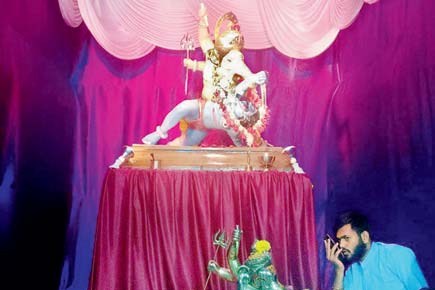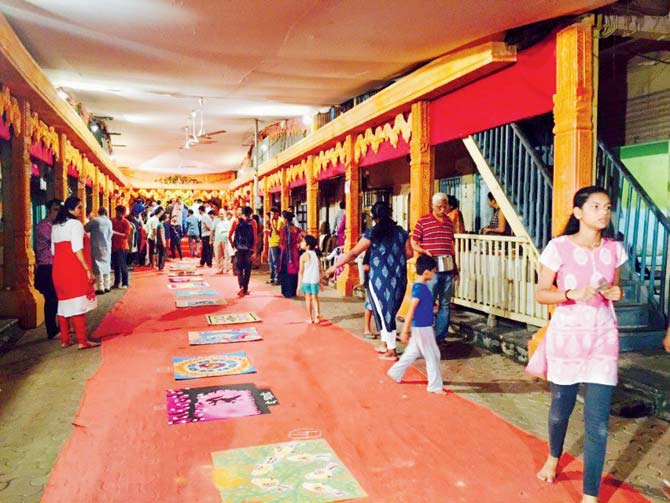Two Ganpati mandals across two cities continue to live the spirit and intent of Ganeshotsav, well over a century since they were established


Bhau Rangari Ganesh Trust
 The lady constable directed us with a polite, "Saral" that was nearly lost amid the bustle and din around us. Devotees, visitors and tourists were requested to leave their vehicles behind a point, to make way in one direction. It made our mission in halting rain even more special as we were able to soak in the sights and sounds having to negotiate only one kind of traffic. We were in the heart of old Pune, near Shaniwarwada to visit possibly India's oldest Ganesh mandal that was set up 126 years ago by medical practitioner Bhau Javale, popularly known as Bhau Rangari.
The lady constable directed us with a polite, "Saral" that was nearly lost amid the bustle and din around us. Devotees, visitors and tourists were requested to leave their vehicles behind a point, to make way in one direction. It made our mission in halting rain even more special as we were able to soak in the sights and sounds having to negotiate only one kind of traffic. We were in the heart of old Pune, near Shaniwarwada to visit possibly India's oldest Ganesh mandal that was set up 126 years ago by medical practitioner Bhau Javale, popularly known as Bhau Rangari.

Keshavji Naika Chawl
Unadulterated devotion
Feriwallahs, kohl-eyed performers and deep-throated vendors of every kind had dotted the main road as well as the bylanes. Despite the grand spectacle around the state's favourite deity, we could sense unadulterated devotion in every pandal. No loudspeakers blaring the latest Bollywood hits, no brass bands or dhol groups competing with each other, and much to our delight, all the idols – big and small – were in full display to the public eye. In fact, with no eye-catching, glitzy signage, we very nearly missed the Bhau Rangari Ganpati Trust pandal. A timely query to a shopkeeper saw us make a quick u-turn to head into a nondescript gully. Above us, a mime skit on the evils of cyber crime was being enacted on a massive stage by a bunch of youth as a voiceover in Marathi ensured passersby followed proceedings.
Untouched by time
As we walked further into the gully, the sounds from the main road faded away. All of a sudden, out of nowhere our eyes spotted a banner at a smallish pandal that mentioned its significance. Only then did we realise that we had reached the right spot. The idol was a lot tinier than we had anticipated. Around us, residents of the peaceful middle-class neighbourhood seemed untouched by the need to showcase the landmark. On the contrary, we spotted them entertain guests in the mandal's old office, and bond over the festival in true community style. The rickety staircases, the door knobs and the house numbers of the area also seemed untouched by time.
A few days later, we were back on the Ganpati trail. This time, we were at Keshavji Naik Chawl in Girgaum, where Bal Gangadhar Tilak started the Ganeshotsav 125 years ago. The chawl surrounding the main idol was decked up in simple lighting; hand-made rangolis of all shapes and sizes were displayed by its residents, and children hopped around offering devotees and visitors prasad from stainless steel thaalis. Aajis and ajobas seated on plastic chairs watched goings-on from their porches.
Lilting traditional bhajans played softly in the background. Even the décor complimented the architecture of the chawl – simple and effective with community written all over. A far cry from what we had witnessed during our commute halfway across the city to reach the iconic mandal. As the friend spent moments in prayer, yours truly's attention was drawn by perhaps the lone sign of changing times in this pocket that lay cocooned in the past – a poster mentioned a Facebook page, a Twitter handle and an official website of the mandal.
Spreading an idea
At both locations, as we spent a few moments taking it all in, it dawned on us. That mention of the origins of Ganeshotsav in our history textbooks was making perfect sense, finally. This must have been how Maharashtra's enlightened minds had envisioned Ganeshotsav – as a platform to spread a common idea and strengthen community bonding. They were certainly way ahead of their times.
mid-day's Features Editor Fiona Fernandez relishes the city's sights, sounds, smells and stones...wherever the ink and the inclination takes her. She tweets @bombayana. Send your feedback to mailbag@mid-day.com
 Subscribe today by clicking the link and stay updated with the latest news!" Click here!
Subscribe today by clicking the link and stay updated with the latest news!" Click here!









